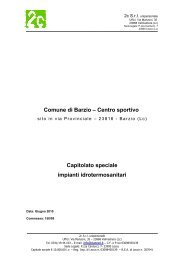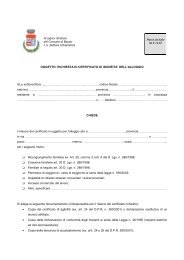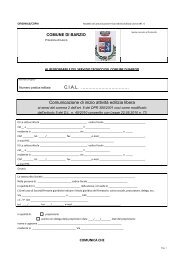155 Coldogna Campiano - Comune di Barzio
155 Coldogna Campiano - Comune di Barzio
155 Coldogna Campiano - Comune di Barzio
Create successful ePaper yourself
Turn your PDF publications into a flip-book with our unique Google optimized e-Paper software.
350.000<br />
300.000<br />
250.000<br />
200.000<br />
150.000<br />
100.000<br />
50.000<br />
0<br />
Quantità (mc/anno)<br />
Torrente<br />
Stabine Torrente<br />
Valle dei<br />
Faggi<br />
Torrente<br />
Bobbia<br />
Torrente<br />
Gerone<br />
Dalle quantità espresse emerge la sorgente del torrente Gerone, da cui il comune potrebbe prelevare le maggiori<br />
quantità <strong>di</strong> acqua esclusivamente per uso potabile, con un apporto idrico <strong>di</strong> 315.360 mc/anno, seguita<br />
dalla sorgente Bobbia, con un volume concesso <strong>di</strong> 94.608 mc/anno e il 18% della <strong>di</strong>sponibilità idrica teorica<br />
comunale (ammontante a quasi 540 mila mc/anno, dato poi confrontato con l’effettiva entità <strong>di</strong> approvvigionamento<br />
idrico comunale, operato a <strong>Barzio</strong> 9 , facendo così stimare la dotazione pro capite giornaliera).<br />
Sorgente Portata effettiva (l/s) Dotazione pro – capite (l/ab*g) mc/giorno mc/anno<br />
Bobbia (<strong>Barzio</strong>) 2,3 33 199 72.635<br />
Gerone (<strong>Barzio</strong>) 2,3 33 199 72.635<br />
Pesciola (Concenedo) 1,2 35 104 37.960<br />
Lavazzero (Bobbio) 1 17 86 31.390<br />
Totale 6,8 – 588 214.620<br />
Emerge come, a fronte d’una concessione massima <strong>di</strong> quasi 540 mila mc/anno, la quantità d’acqua effettivamente<br />
captata dalle sorgenti sia <strong>di</strong> 215 mila mc/anno, inferiore quin<strong>di</strong> d’oltre il 50% alla <strong>di</strong>sponibilità teorica<br />
massima, con livelli <strong>di</strong> captazione maggiori registrati per le sorgenti Bobbia e Gerone, da cui viene derivato<br />
più del 30% dei volumi d’acqua potabile introdotti in acquedotto.<br />
Infine, è stato analizzato l’andamento dei consumi idrici registrati nel periodo <strong>di</strong> tempo 2004 – 2009 10 :<br />
Anno<br />
Consumi<br />
(mc)<br />
2004 185.219<br />
2005 191.906<br />
2006 124.161<br />
2007 180.000<br />
2008 139.081<br />
2009 135.374<br />
Valore massimo 191.000<br />
Valore me<strong>di</strong>o 160.000<br />
200.000<br />
150.000<br />
100.000<br />
50.000<br />
0<br />
2004<br />
2005 2006<br />
Consumi (mc)<br />
2007<br />
2008<br />
2009<br />
Consumi (mc)<br />
Il grafico mostra un andamento alquanto variabile nell’intervallo che vede le quote <strong>di</strong> 124 mila mc/anno <strong>di</strong><br />
consumo minimo (registrato nell’anno 2006) e <strong>di</strong> 191 mila mc/anno <strong>di</strong> consumo massimo, nel 2009, con un<br />
9 Fonte dati: Schede <strong>di</strong> censimento dello “stato <strong>di</strong> fatto dei servizi idrici”, ATO 2007.<br />
10 Fonte dati: Regione Lombar<strong>di</strong>a, struttura gestione tributi regionali.<br />
232






